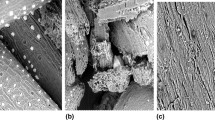Abstract
Oil sorbents for cleanup operation should be of high sorption capacity, biodegradable, readily available, and low-cost. This is important for protection of the water environment, especially for oil spillage. Corn silk is a low-cost sorbent. In this study corn silk was treated by acetylation process to improve the sorption capacity. The process involved acetylation by acetic anhydride using N-bromosuccinimide (NBS) as a catalyst. Reaction time of 1, 3, 6, and 9 h, temperature of 90-120 °C and percentage of catalyst of 1-3 % were used in the experiment. The results showed that the highest oil sorption was 11.45 % weight percent gain (WPG). This was achieved at 3 % catalyst concentration in acetic anhydride and temperature of 120 °C for 6 h. A weight percent gain of 11.45 % was achieved. The effect of contact time on oil sorption capacity for different crude oil (Tapis and Arabian crude oils) was investigated. In general the sorption capacity reduced after the fifth cycle of sorption/ desorption. The characteristics of raw and treated corn silk were examined using FT-IR and FE-SEM. The treated corn silk as an organic waste material was found to have higher sorption capacity than that of the commercial synthetic sorbents such as polypropylene. This agriculture waste may be used to replace those of non-biodegradable oil sorbents.
Similar content being viewed by others
References
R. Asadpour, N. B. Sapari, Z. Z. Tuan, H. Jusoh, A. Riahi, and K. U. Orji, Caspian J. Appl. Sci. Res., 2, 46 (2013).
M. Inagaki, K. Shibata, S. Setou, M. Toyoda, and J. Aizawa, Desalination, 128, 213 (2000).
H. M. Choi and R. M. Cloud, Environ. Sci. Technol., 26, 772 (1992).
T. T. Lim and X. Huang, Ind. Crop. Prod., 26, 125 (2007).
S. Suni, A. L. Kosunen, M. Hautala, A. Pasila, and M. Romantschuk, Mar. Pollut. Bull., 49, 916 (2004).
X.-F. Sun, R. Sun, and J.-X. Sun, J. Agric. Food Chem., 22, 6428 (2002).
R. Asadpour, N. B. Sapari, M. H. Isa, and K. U. Orji, Appl. Mech. Mater., 567, 74 (2014).
K. L. Kadam and J. D. McMillan, Bioresource Technol., 88, 17 (2003).
M. D. Falls, Ph. D. Dissertation, A&M University, Texas, 2011.
M. Perera, W. Qin, M. Yandeau-Nelson, L. Fan, P. Dixon, and B. J. Nikolau, Plant J., 64, 618 (2010).
J. Liu, C. Wang, Z. Wang, C. Zhang, S. Lu, and J. Liu, Food Chem., 126, 261 (2011).
R. Asadpour, N. B. Sapari, M. H. Isa, and K. U. Orji, Water Sci. Technol., 70, 1220 (2014).
J. Ren, R. Sun, C. Liu, Z. Cao, and W. Luo, Carbohydr. Polym., 70, 406 (2007).
X. Sun, R. Sun, and J. Sun, Bioresource Technol., 95, 343 (2004).
M. Teli and S. P. Valia, Carbohydr. Polym., 92, 915 (2013).
M. O. Adebajo and R. L. Frost, Spectroc. Acta Pt. A-Molec. Biomolec. Spectr., 60, 2315 (2004).
J. Wang and A. Wang, Fiber. Polym., 14, 1834 (2013).
K. A. Connors and K. S. Albert, J. Pharm. Sci., 62, 845 (1973).
B. Karimi and H. Seradj, Synlett, 4, 519 (2001).
H. M. Choi and J. P. Moreau, Microsc. Res. Techniq., 25, 447 (1993).
M. Khalil, A. Hashem, and A. Hebeish, Starch-Stärke, 47, 394 (1995).
R. M. Rowell, R. Simonson, and A.-M. Tillman, Holzforschung, 44, 263 (1990).
M. Teli and S. P. Valia, Fiber. Polym., 14, 915 (2013).
Author information
Authors and Affiliations
Corresponding author
Rights and permissions
About this article
Cite this article
Asadpour, R., Sapari, N.B., Isa, M.H. et al. Acetylation of corn silk and its application for oil sorption. Fibers Polym 16, 1830–1835 (2015). https://doi.org/10.1007/s12221-015-4745-8
Received:
Accepted:
Published:
Issue Date:
DOI: https://doi.org/10.1007/s12221-015-4745-8




